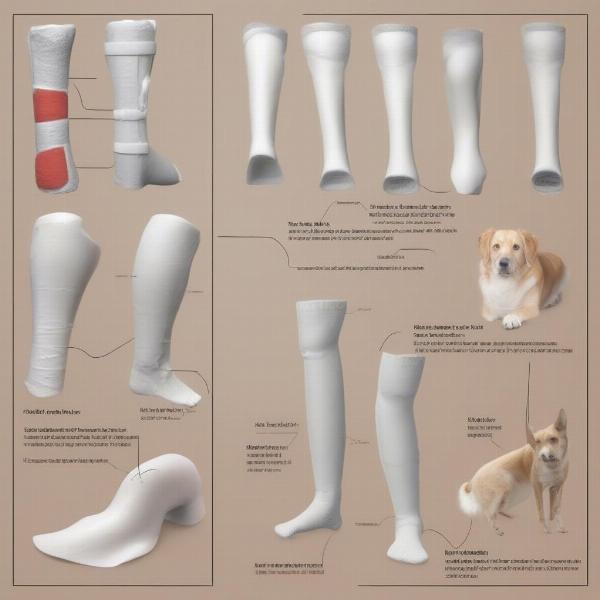A dog leg cast, often necessary for fractures, sprains, or post-surgery recovery, plays a crucial role in ensuring your furry friend heals properly. This guide provides valuable insights into dog leg casts, covering everything from types and application to care and potential complications. Understanding the intricacies of a cast for a dog’s leg is essential for any responsible pet owner.
Types of Dog Leg Casts and Their Applications
Several types of casts are used for dog leg injuries, each designed for specific purposes:
- Fiberglass Casts: Lightweight, durable, and water-resistant, fiberglass casts are a common choice. They offer excellent support and are suitable for various fractures.
- Plaster Casts: While heavier than fiberglass, plaster casts are more moldable and affordable. They are often preferred for complex fractures requiring precise shaping.
- Splints: Used for less severe injuries or as a temporary measure before casting, splints provide support and immobilization while allowing some flexibility.
- Cast Braces: Combining the stability of a cast with the mobility of a brace, cast braces are useful in specific cases where controlled movement is beneficial.
 Different Types of Dog Leg Casts
Different Types of Dog Leg Casts
Choosing the right cast depends on the type and severity of the injury, your dog’s size and activity level, and your veterinarian’s recommendations.
Caring for a Dog with a Leg Cast
Proper cast care is crucial for a smooth recovery:
- Keep the Cast Clean and Dry: Moisture can weaken the cast and cause skin irritation. Avoid letting your dog swim or walk in wet areas.
- Monitor for Sores or Swelling: Regularly check the skin around the cast for redness, sores, or swelling. Contact your vet immediately if you notice any issues.
- Prevent Chewing or Licking: Use an Elizabethan collar (cone) to prevent your dog from chewing or licking the cast, which can damage it or introduce infection.
- Restrict Activity: Limit your dog’s movement to short, supervised leash walks for bathroom breaks. Avoid running, jumping, or playing until the cast is removed.
Potential Complications and When to Seek Veterinary Help
While casts are generally safe, complications can arise:
- Sores and Infections: Pressure sores or infections can develop under the cast. Watch for foul odors, discharge, or excessive licking.
- Cast Slipping or Breakage: A loose or broken cast can be ineffective and may cause further injury. Contact your vet if the cast becomes damaged.
- Swelling or Pain: Increased swelling or pain can indicate a problem. Seek veterinary attention if your dog seems uncomfortable or the swelling worsens.
What to Expect After Cast Removal
Once the cast is removed, your dog may experience some stiffness and muscle weakness. Your vet might recommend:
- Physical Therapy: Exercises and stretches can help restore strength and mobility.
- Gradual Return to Activity: Slowly increase your dog’s activity level over time to avoid re-injury.
- Follow-up Examinations: Regular check-ups are important to ensure proper healing.
Conclusion
A cast for a dog’s leg is an important tool for healing various injuries. By understanding the different types of casts, proper care techniques, and potential complications, you can help your furry friend recover comfortably and effectively. If you have any concerns, always consult your veterinarian.
FAQ
- How long does a dog usually wear a leg cast? The duration varies depending on the injury, typically ranging from a few weeks to several months.
- Can my dog walk with a leg cast? Limited, supervised walks are usually permitted for bathroom breaks.
- Is it normal for my dog to lick the cast? Licking should be discouraged as it can damage the cast and introduce infection. An e-collar can help.
- What should I do if the cast gets wet? Contact your vet immediately as moisture can weaken the cast and cause skin problems.
- How can I tell if my dog is in pain? Signs of pain can include whining, limping, restlessness, and decreased appetite.
- What is the recovery process like after cast removal? Recovery involves gradual return to activity and potentially physical therapy.
- How much does a dog leg cast cost? The cost depends on factors like the type of cast, the size of the dog, and the vet’s fees.
Related Articles
About ILM Dog
ILM Dog is your go-to resource for expert dog care advice. We offer a wealth of information on dog breeds, health, training, nutrition, and more. Our mission is to empower dog owners with the knowledge and resources they need to provide the best possible care for their beloved companions. From choosing the right breed to managing health issues and understanding canine behavior, we cover all aspects of responsible dog ownership. For expert advice tailored to your dog’s specific needs, contact us at [email protected] or call us at +44 20-3965-8624. Connect with ILM Dog today at https://ilmdog.com for all your dog care needs!